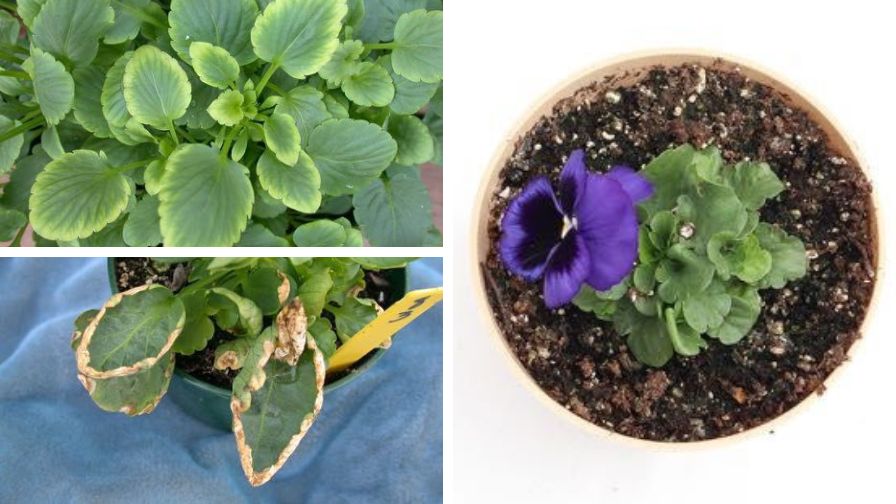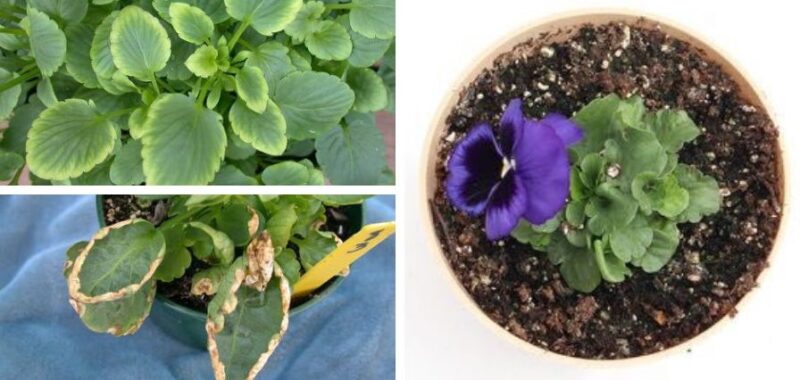
(Clockwise from Top Left) Pansy interveinal chlorosis from iron deficiency, dark foliage and leaf crinkling from PGR overdose, and lower leaf scorch from low EC levels | Brian E. Whipker, and Patrick Veazie
With the fall bloom of pansies starting during the high heat of summer, growers need to learn how to manage nutrition and other production concerns as the crop carries into autumn. Thankfully, Brian E. Whipker and Patrick Veazie of North Carolina State University recently put out a pair of e-Gro alerts covering such a topic. Here’s a look at their thoughts on keeping fall pansies healthy and thriving throughout fall.
Fall Pansies – High pH Problems
Whipker and Veazie note that “One of the most common problems with fall pansy production is iron deficiency.” This is often observed with the appearance of interveinal chlorosis (tissue yellowing) in new leaves and foliage.
The most common causes of iron deficiency are overwatering and high pH levels, induced through the substrate. To alleviate and prevent iron deficiency and its accompanying symptoms, the pair recommended the close monitoring of root zone conditions and maintaining a “root zone pH of 5.5-6.2.”
Fall Pansies – Low pH Problems
On the other hand, there can be low pH problems stemming from the root zone. When the substrate pH is too low, the most common symptom to emerge is that of “lower leaf purple-black discoloration). However, the short and swift growing period of pansies in autumn usually means that “there is little time for these symptoms to manifest.” Outside of the fall growing period, preventative measures include testing and maintaining substrate pH levels.
Fall Pansies – Low EC Problems
As previously stated, the production of pansies is relatively quick. While this helps mitigate some risks, it exacerbates others, one of which is electrical conductivity (EC) levels, which are crucial in the plant growth process. Lower than optimal EC levels can result in lower leaf chlorosis and stunted growth. One way this can happen, especially in fall weather, is rain and wind displacing fertilizer from a plant pot or container.
Following heavy rain where fertilizer displacement has or is suspected to have occurred, the best practice is to irrigate affected plants with a fertilizer solution to replace and supplement what was lost.
Fall Pansies – High EC Problems
Again, on the flip side, there is the case of high EC levels. The most common cause of high EC levels is the miscalculation of fertilization rates and lack of testing to maintain levels. This, in turn, brings about symptoms of “lower leaf scorch.” Cutting the substrate with “clear water irrigations” will help dilute it and lower the EC to needed levels.
Fall Pansies – Boron Deficiency
Boron deficiency in fall pansy production usually occurs “during the plug stage when excessive moisture inhibits B uptake via transpiration by the actively growing plug.” The result leads to typical symptoms of “distortion and curling” of new growth. Minor symptoms of boron deficiency are often overcome by the plant throughout its growing process, but plants with more accelerated and prolonged symptoms are unlikely to recover, leading to a failure to bloom.
Fall Pansies – Boron Toxicity
Due to boron deficiency prevalence in pansies, and the lack of a cure resulting in plant failure, boron applications are often used on pansy populations. However, because of this, the opposite of the intended effect can happen, leading to boron overdoses, which in turn cause toxicity.
Regarding symptoms, Whipker and Veazie state “Lower leaves develop necrotic spotting along the leaf margins, and with the initial symptoms they occur at the hydathodes along the leaf margin.” Keeping an eye out for symptoms can help prevent the spread of necrosis to the entire plant.
Fall Pansies – Plant Growth Regulators
Plant growth regulators (PGRs) are often used to better control fall pansy growth during the change of season, where temperature changes can lead to unintended effects, such as overgrowth and stretched tissue. However, pansies, in particular, are susceptible to “species sensitivity,” requiring careful monitoring. Due to this sensitivity, PGR application on pansies can easily result in an overdose, creating a variety of visual symptoms that make them incompatible for market consumption.
Whipker and Veazie recommend the following steps to prevent PGR overdose:
- Review culture guides
- Use during optimal application conditions
- Don’t apply PGRs to stressed plants
- Avoid excessive/heavy irrigation during and after PGR applications
- Utilize additional, non-chemical growth control methods
For more information regarding fall pansy production best practices, please read the full e-Gro (Electronic Grower Resources Online) alerts “The Highs and Lows of Pansy Nutritional Problems“ and “Pansy PGR Overdose.” Additional and current e-Gro alert pieces from Volume 13 (2024) can be found online.
0
1
5
How to Handle Pansy Production Concerns in the Fall

